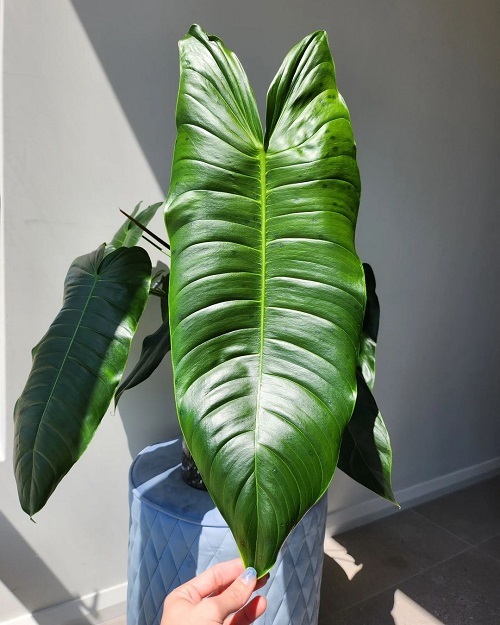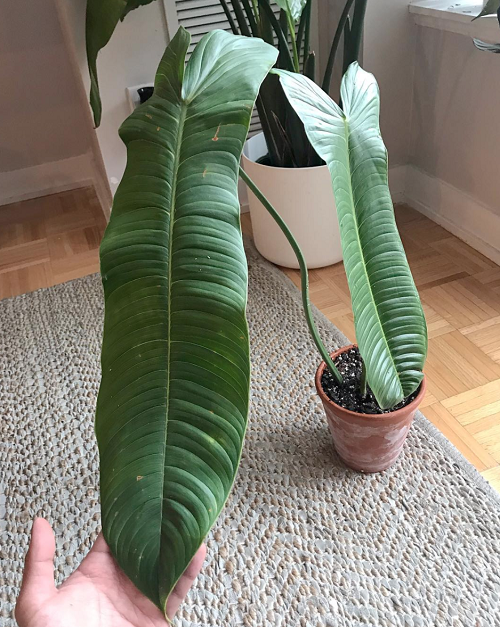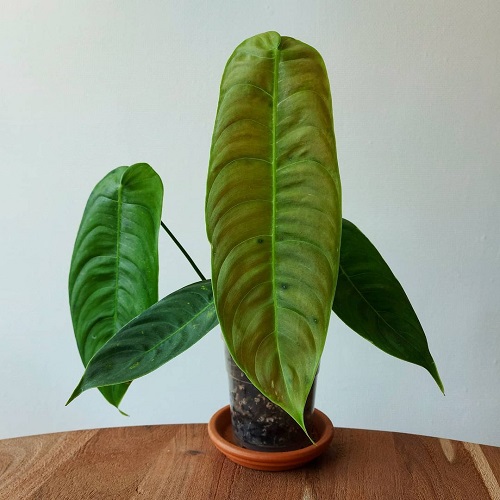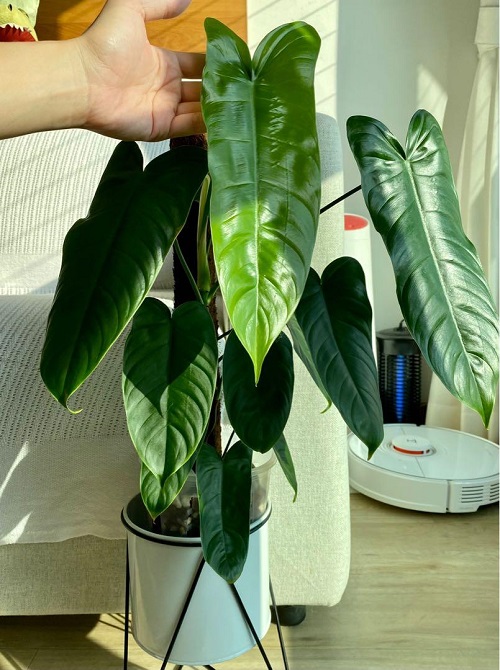Philodendron Sharoniae – A beautiful plant with leaves that can be upto 3-4 feet long in the right growing conditions!
Philodendron Sharoniae—This rare and unique plant is not just another decorative piece; it’s a living spectacle characterized by its elongated, ribbon-like leaves and dramatic variegation.
Check out Philodendron Green Princess Care and Growing Guide here
Philodendron Sharoniae Information
The Philodendron Sharoniae originates from the tropical rainforests of Ecuador and parts of Colombia. This rare variety is a member of the extensive Philodendron genus, which boasts hundreds of diverse species.
The Philodendron Sharoniae is notable for its elongated, lanceolate leaves, which can reach up to 24 inches in length in optimal conditions. The leaves display stunning variegation, with patterns that can range from light green to a deep, forest green.
The foliage appears to be delicately etched or pinstriped, making it a striking focal point in any space.
The plant has a climbing habit, meaning it will thrive best when provided with a sturdy support like a moss pole or trellis. As it matures, the leaves tend to grow larger and the variegation becomes even more pronounced, turning it into an even more eye-catching specimen.
Check Out Philodendron Tortum Care and Growing Guide here
Propagating Philodendron Sharoniae
Stem Cuttings Propagation (Easiest Method):
- Begin by choosing a healthy stem of the parent plant with at least a few nodes (small bumps on the stem where leaves and roots grow from).
- Using a clean, sharp pair of scissors or pruning shears, cut a section of the stem just below a node. Make sure the cutting is around 4-6 inches long and should have at least one or two leaves attached.
- Let the cut end of the stem air dry for a few hours. This helps prevent rotting when you plant it.
- Fill a small pot with a well-draining potting mix. Insert the cut end of the stem into the soil, ensuring the node (where you made the cut) is buried in the soil. Water the soil lightly.
- Place the potted cutting in a warm, bright location with indirect sunlight. Keep the soil consistently moist but not soggy.
- Over the course of a few weeks to a few months, the cutting should develop roots. You can gently tug on the cutting to check for resistance, which indicates root growth.
- Once the cutting has established a good root system, it can be transplanted into a larger pot with regular potting soil or placed in its permanent location.
Check the Philodendron Ring of Fire Growing Guide here
Best Pot Size for Growing Philodendron Sharoniae

You can start the plant in a 8-10 inches pot, which will be good for 2-3 years. As the plant grows and spreads, re-pot it into 1 size bigger pot than the old one.
Take a look at the Best Large-leaf Philodendron Varieties here
Requirements for Growing Philodendron Sharoniae

Sunlight
Given that Philodendron Sharoniae has large, elongated leaves, optimizing its exposure to sunlight is critical for its overall health and vibrance.
Positioning
- Elevated Placement: Consider placing the plant on a higher shelf or hanging it from the ceiling. This ensures that the large leaves get uniform light exposure without obstructing other plants.
- Angled Exposure: When positioning the plant, aim to angle the leaves so they each receive adequate sunlight. This could mean slightly rotating the plant every few days.
- Proximity to Windows: Place the plant near a window with bright, indirect light. East or North-facing windows are generally the best choices for this species.
Support Structures
- Moss Pole or Trellis: Using a support structure like a moss pole or trellis can help the leaves grow vertically, thus getting better exposure to sunlight.
- Adjustable Plant Stand: Consider using an adjustable plant stand that can be raised or lowered. This allows you to change the plant’s height in relation to the sunlight.
Light Diffusion
- Sheer Curtains: Use sheer curtains on windows to diffuse the natural light, helping to prevent the leaves from getting scorched by direct sunlight.
- Artificial Lights: In darker rooms, supplement natural light with artificial grow lights specifically designed for plants.
Find How to Grow and Care For Philodendron Bloody Mary here
Soil
Philodendron Sharoniae thrives in a well-draining potting mix. Go for:
- 2 parts Coconut Coir or Peat Moss
- 1 part Perlite
- 1 part Compost
Optional:
- 1/2 part Vermiculite (if you need more water retention)
- 1/2 part Worm Castings (for added nutrients)
Water
Water Philodendron Sharoniae moderately, allowing the top inch of soil to dry before watering. Typically, water every 1-2 weeks, depending on humidity levels and the pot’s size.
Use room-temperature water and water the soil directly, avoiding the leaves to prevent fungal issues. Adjust the frequency based on environmental conditions.
Temperature and Humidity
Maintain temperatures between 65-90°F (18-32°C) for Philodendron Sharoniae. It thrives in normal indoor room temperatures. Keep humidity levels moderate, around 40-60%.
If the air is too dry, use a humidifier or mist the plant occasionally. Avoid exposure to drafts or sudden temperature fluctuations to ensure its well-being.
Philodendron Sharoniae Care

Fertilizer
A balanced liquid fertilizer, with an N-P-K ratio of 20-20-20, is generally suitable for Philodendron Sharoniae. Liquid fertilizers allow for quick nutrient absorption.
- Fertilize every 4-6 weeks after diluting the feed to 1/2 of its strength. The plant is in its active growing phase during these months and will benefit from more frequent feeding. Also, do not feed in winter.
- Given the large leaf surface area, a diluted liquid fertilizer can be applied as a foliar spray. This allows for quick nutrient absorption through the leaves but should be done sparingly to avoid fertilizer burn.
Pruning
Prune Philodendron Sharoniae to maintain its shape and encourage bushier growth. Use clean, sharp scissors or pruning shears to trim leggy stems and dead or yellowing leaves.
You can prune at any time of the year, but it’s often best done in spring or early summer when the plant is actively growing.
Find Everything About Growing Philodendron Painted Lady here
Pests
- Spider Mites: These tiny insects can create webs on the leaves and cause yellowing. Regularly misting the plant and keeping humidity levels up can deter spider mites.
- Aphids: Aphids may feed on the plant’s sap, causing distorted growth. They can be removed with a strong stream of water or with insecticidal soap.
- Mealybugs: These white, cottony insects can infest the foliage. Isolate and remove affected parts or use neem oil to control them.
- Scale Insects: Scale insects attach to stems and leaves, sucking sap. Use rubbing alcohol on a cotton swab to remove them.
Diseases:
- Root Rot: Overwatering or poorly draining soil can lead to root rot. Ensure proper watering practices and well-draining soil.
- Leaf Spot: Fungal leaf spot can occur in humid conditions. Prune affected leaves and improve air circulation.
- Bacterial Blight: Caused by waterborne bacteria, it manifests as brown or yellow spots on leaves. Isolate affected plants and avoid overhead watering.


